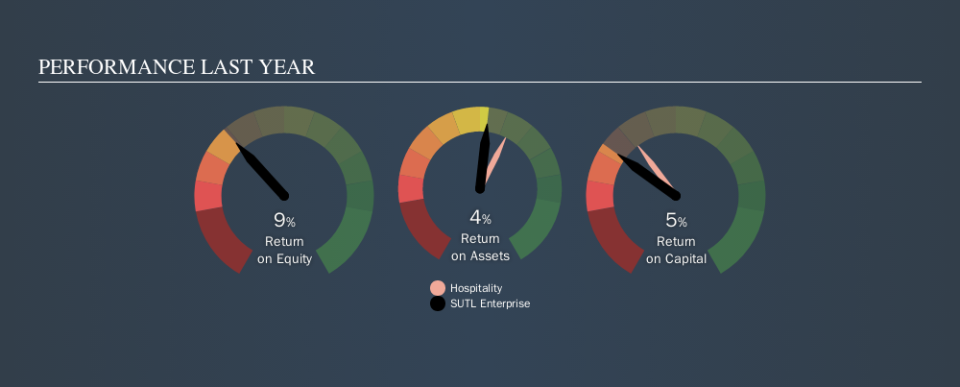Shareholders Should Look Hard At SUTL Enterprise Limited’s (SGX:BHU) 5.5%Return On Capital

Today we'll evaluate SUTL Enterprise Limited (SGX:BHU) to determine whether it could have potential as an investment idea. Specifically, we're going to calculate its Return On Capital Employed (ROCE), in the hopes of getting some insight into the business.
First of all, we'll work out how to calculate ROCE. Second, we'll look at its ROCE compared to similar companies. Finally, we'll look at how its current liabilities affect its ROCE.
Return On Capital Employed (ROCE): What is it?
ROCE measures the amount of pre-tax profits a company can generate from the capital employed in its business. In general, businesses with a higher ROCE are usually better quality. In brief, it is a useful tool, but it is not without drawbacks. Renowned investment researcher Michael Mauboussin has suggested that a high ROCE can indicate that 'one dollar invested in the company generates value of more than one dollar'.
How Do You Calculate Return On Capital Employed?
Analysts use this formula to calculate return on capital employed:
Return on Capital Employed = Earnings Before Interest and Tax (EBIT) ÷ (Total Assets - Current Liabilities)
Or for SUTL Enterprise:
0.055 = S$6.2m ÷ (S$124m - S$11m) (Based on the trailing twelve months to June 2019.)
Therefore, SUTL Enterprise has an ROCE of 5.5%.
View our latest analysis for SUTL Enterprise
Does SUTL Enterprise Have A Good ROCE?
When making comparisons between similar businesses, investors may find ROCE useful. In this analysis, SUTL Enterprise's ROCE appears meaningfully below the 7.4% average reported by the Hospitality industry. This performance is not ideal, as it suggests the company may not be deploying its capital as effectively as some competitors. Separate from how SUTL Enterprise stacks up against its industry, its ROCE in absolute terms is mediocre; relative to the returns on government bonds. It is possible that there are more rewarding investments out there.
We can see that, SUTL Enterprise currently has an ROCE of 5.5%, less than the 7.6% it reported 3 years ago. So investors might consider if it has had issues recently. The image below shows how SUTL Enterprise's ROCE compares to its industry, and you can click it to see more detail on its past growth.
When considering this metric, keep in mind that it is backwards looking, and not necessarily predictive. ROCE can be misleading for companies in cyclical industries, with returns looking impressive during the boom times, but very weak during the busts. This is because ROCE only looks at one year, instead of considering returns across a whole cycle. How cyclical is SUTL Enterprise? You can see for yourself by looking at this free graph of past earnings, revenue and cash flow.
What Are Current Liabilities, And How Do They Affect SUTL Enterprise's ROCE?
Short term (or current) liabilities, are things like supplier invoices, overdrafts, or tax bills that need to be paid within 12 months. The ROCE equation subtracts current liabilities from capital employed, so a company with a lot of current liabilities appears to have less capital employed, and a higher ROCE than otherwise. To check the impact of this, we calculate if a company has high current liabilities relative to its total assets.
SUTL Enterprise has total liabilities of S$11m and total assets of S$124m. As a result, its current liabilities are equal to approximately 8.7% of its total assets. SUTL Enterprise reports few current liabilities, which have a negligible impact on its unremarkable ROCE.
The Bottom Line On SUTL Enterprise's ROCE
Based on this information, SUTL Enterprise appears to be a mediocre business. Of course, you might find a fantastic investment by looking at a few good candidates. So take a peek at this free list of companies with modest (or no) debt, trading on a P/E below 20.
If you like to buy stocks alongside management, then you might just love this free list of companies. (Hint: insiders have been buying them).
We aim to bring you long-term focused research analysis driven by fundamental data. Note that our analysis may not factor in the latest price-sensitive company announcements or qualitative material.
If you spot an error that warrants correction, please contact the editor at editorial-team@simplywallst.com. This article by Simply Wall St is general in nature. It does not constitute a recommendation to buy or sell any stock, and does not take account of your objectives, or your financial situation. Simply Wall St has no position in the stocks mentioned. Thank you for reading.

